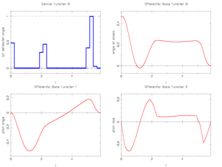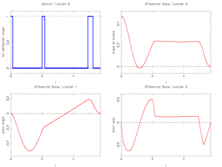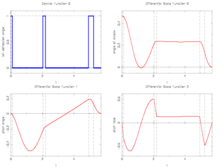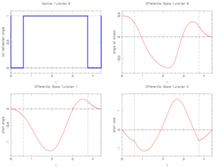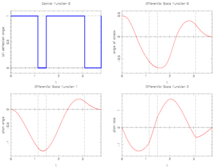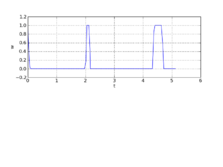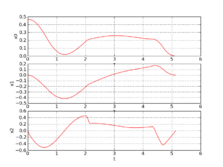F-8 aircraft
| F-8 aircraft | |
|---|---|
| State dimension: | 1 |
| Differential states: | 3 |
| Discrete control functions: | 1 |
| Interior point equalities: | 6 |
The F-8 aircraft control problem is based on a very simple aircraft model. The control problem was introduced by Kaya and Noakes and aims at controlling an aircraft in a time-optimal way from an initial state to a terminal state.
The mathematical equations form a small-scale ODE model. The interior point equality conditions fix both initial and terminal values of the differential states.
The optimal, relaxed control function shows bang bang behavior. The problem is furthermore interesting as it should be reformulated equivalently.
Contents
Mathematical formulation
For ![t \in [0, T]](https://mintoc.de/images/math/e/6/6/e66a2b7fedcba80ccb192b87440f8d9c.png) almost everywhere the mixed-integer optimal control problem is given by
almost everywhere the mixed-integer optimal control problem is given by
![\begin{array}{llcl}
\displaystyle \min_{x, w, T} & T \\[1.5ex]
\mbox{s.t.} & \dot{x}_0 &=& -0.877 \; x_0 + x_2 - 0.088 \; x_0 \; x_2 + 0.47 \; x_0^2 - 0.019 \; x_1^2 - x_0^2 \; x_2 + 3.846 \; x_0^3 \\
&&& - 0.215 \; w + 0.28 \; x_0^2 \; w + 0.47 \; x_0 \; w^2 + 0.63 \; w^3 \\
& \dot{x}_1 &=& x_2 \\
& \dot{x}_2 &=& -4.208 \; x_0 - 0.396 \; x_2 - 0.47 \; x_0^2 - 3.564 \; x_0^3 \\
&&& - 20.967 \; w + 6.265 \; x_0^2 \; w + 46 \; x_0 \; w^2 + 61.4 \; w^3 \\
& x(0) &=& (0.4655,0,0)^T, \\
& x(T) &=& (0,0,0)^T, \\
& w(t) &\in& \{-0.05236,0.05236\}.
\end{array}](https://mintoc.de/images/math/d/2/b/d2bd7e6d1cc8affb72d59248a105d528.png)
 is the angle of attack in radians,
is the angle of attack in radians,  is the pitch angle,
is the pitch angle,  is the pitch rate in rad/s, and the control function
is the pitch rate in rad/s, and the control function  is the tail deflection angle in radians. This model goes back to Garrard<bibref>Garrard1977</bibref>.
is the tail deflection angle in radians. This model goes back to Garrard<bibref>Garrard1977</bibref>.
In the control problem, both initial and terminal values of the differential states are fixed.
Reformulation
The control w(t) is restricted to take values from a finite set only. Hence, the control problem can be reformulated equivalently to
![\begin{array}{llcl}
\displaystyle \min_{x, w, T} & T \\[1.5ex]
\mbox{s.t.} & \dot{x}_0 &=& -0.877 \; x_0 + x_2 - 0.088 \; x_0 \; x_2 + 0.47 \; x_0^2 - 0.019 \; x_1^2 - x_0^2 \; x_2 + 3.846 \; x_0^3 \\
&&& - \left( 0.215 \; \xi - 0.28 \; x_0^2 \; \xi - 0.47 \; x_0 \; \xi^2 - 0.63 \; \xi^3 \right) \; w \\
&&& - \left( - 0.215 \; \xi + 0.28 \; x_0^2 \; \xi - 0.47 \; x_0 \; \xi^2 + 0.63 \; \xi^3 \right) \; (1 - w) \\
& &=& -0.877 \; x_0 + x_2 - 0.088 \; x_0 \; x_2 + 0.47 \; x_0^2 - 0.019 \; x_1^2 - x_0^2 \; x_2 + 3.846 \; x_0^3 \\
&&& + 0.215 \; \xi - 0.28 \; x_0^2 \; \xi + 0.47 \; x_0 \; \xi^2 - 0.63 \; \xi^3 \\
&&& - \left( 0.215 \; \xi - 0.28 \; x_0^2 \; \xi - 0.63 \; \xi^3 \right) \; 2 w \\
& \dot{x}_1 &=& x_2 \\
& \dot{x}_2 &=& -4.208 \; x_0 - 0.396 \; x_2 - 0.47 \; x_0^2 - 3.564 \; x_0^3 \\
&&& - \left( 20.967 \; \xi - 6.265 \; x_0^2 \; \xi -46 \; x_0 \; \xi^2 - 61.4 \; \xi^3 \right) \; w \\
&&& - \left( - 20.967 \; \xi + 6.265 \; x_0^2 \; \xi -46 \; x_0 \; \xi^2 + 61.4 \; \xi^3 \right) \; (1 - w) \\
& &=& -4.208 \; x_0 - 0.396 \; x_2 - 0.47 \; x_0^2 - 3.564 \; x_0^3 \\
&&& + 20.967 \; \xi - 6.265 \; x_0^2 \; \xi + 46 \; x_0 \; \xi^2 - 61.4 \; \xi^3 \\
&&& - \left( 20.967 \; \xi - 6.265 \; x_0^2 \; \xi - 61.4 \; \xi^3 \right) \; 2 w \\
& x(0) &=& (0.4655,0,0)^T, \\
& x(T) &=& (0,0,0)^T, \\
& w(t) &\in& \{0,1\},
\end{array}](https://mintoc.de/images/math/0/4/a/04a0e56e2d185c764c658785ce00ade8.png)
with  . Note that there is a bijection between optimal solutions of the two problems.
. Note that there is a bijection between optimal solutions of the two problems.
Reference solutions
We provide here a comparison of different solutions reported in the literature. The numbers show the respective lengths  of the switching arcs with the value of
of the switching arcs with the value of  on the upper or lower bound (given in the second column). Claim denotes what is stated in the respective publication, Simulation shows values obtained by a simulation with a Runge-Kutta-Fehlberg method of 4th/5th order and an integration tolerance of
on the upper or lower bound (given in the second column). Claim denotes what is stated in the respective publication, Simulation shows values obtained by a simulation with a Runge-Kutta-Fehlberg method of 4th/5th order and an integration tolerance of  .
.
| Arc | w(t) | Lee et al.<bibref>Lee1997a</bibref> | Kaya<bibref>Kaya2003</bibref> | Sager<bibref>Sager2005</bibref> | Schlueter/ Gerdts | Sager |
|---|---|---|---|---|---|---|
| 1 | 1 | 0.00000 | 0.10292 | 0.10235 | 0.0 | 1.13492 |
| 2 | 0 | 2.18800 | 1.92793 | 1.92812 | 0.608750 | 0.34703 |
| 3 | 1 | 0.16400 | 0.16687 | 0.16645 | 3.136514 | 1.60721 |
| 4 | 0 | 2.88100 | 2.74338 | 2.73071 | 0.654550 | 0.69169 |
| 5 | 1 | 0.33000 | 0.32992 | 0.32994 | 0.0 | 0.0 |
| 6 | 0 | 0.47200 | 0.47116 | 0.47107 | 0.0 | 0.0 |
| Claim: Infeasibility | - | 1.00E-10 | 7.30E-06 | 5.90E-06 | 3.29169e-06 | 2.21723e-07 |
| Claim: Objective | - | 6.03500 | 5.74217 | 5.72864 | 4.39981 | 3.78086 |
| Simulation: Infeasibility | - | 1.75E-03 | 1.64E-03 | 5.90E-06 | 3.29169e-06 | 2.21723e-07 |
| Simulation: Objective | - | 6.03500 | 5.74218 | 5.72864 | 4.39981 | 3.78086 |
The best known optimal objective value of this problem given is given by  . The corresponding solution is shown in the rightmost plot. The solution of bang-bang type switches three times, starting with
. The corresponding solution is shown in the rightmost plot. The solution of bang-bang type switches three times, starting with  .
.
- Reference solution plots
Source Code
C
The differential equations in C code:
double x1 = xd[0]; double x2 = xd[1]; double x3 = xd[2]; #ifdef CONVEXIFIED double xi = 0.05236; rhs[0] = -0.877*x1 + x3 - 0.088*x1*x3 + 0.47*x1*x1 - 0.019*x2*x2 -x1*x1*x3 + 3.846*x1*x1*x1 + 0.215*xi - 0.28*x1*x1*xi + 0.47*x1*xi*xi - 0.63*xi*xi*xi - 2*u[0] * ( 0.215*xi - 0.28*x1*x1*xi - 0.63*xi*xi*xi ); rhs[1] = x3; rhs[2] = - 4.208*x1 - 0.396*x3 - 0.47*x1*x1 - 3.564*x1*x1*x1 + 20.967*xi - 6.265*x1*x1*xi + 46*x1*xi*xi - 61.4*xi*xi*xi - 2*u[0] * ( 20.967*xi - 6.265*x1*x1*xi - 61.4*xi*xi*xi ); #else double u_ = -0.05236 + u[0]*2.0*0.05236; rhs[0] = -0.877*x1 + x3 - 0.088*x1*x3 + 0.47*x1*x1 - 0.019*x2*x2 -x1*x1*x3 + 3.846*x1*x1*x1 - 0.215*u_ + 0.28*x1*x1*u_ + 0.47*x1*u_*u_ + 0.63*u_*u_*u_; rhs[1] = x3; rhs[2] = -4.208*x1 - 0.396*x3 - 0.47*x1*x1 - 3.564*x1*x1*x1 - 20.967*u_ + 6.265*x1*x1*u_ + 46*x1*u_*u_ + 61.4*u_*u_*u_; #endif
Optimica
Model description in Optimica.Solver=Ipopt Objective : 5.12799232 infeasibility : 6.2235588037251599e-10
package F8_aircraft_pack optimization F8_aircraft_Opt (objective = tf, startTime = 0, finalTime = 1) // The time is scaled so that the new // time variable, call it \tau, // is related to the original time, // call it t as \tau=tf*t where tf // is a parameter to be minimized // subject to the dynamics // \dot x = tf*f(x,w) // Parameters parameter Real tf(free=true,min=0.1); parameter Real ksi=0.05236; // The states Real x0(start=0.4655); //angle of attack Real x1(start=0); //pitch angle Real x2(start=0); //pitch rate // The control signal input Real w(min=0,max=1); equation der(x0)= tf*(-0.877*x0 + x2 - 0.088*x0*x2 + 0.47*x0^2 - 0.019*x1^2 -x0^2*x2 + 3.846*x0^3 -(0.215*ksi -0.28*x0^2*ksi -0.47*x0*ksi^2 - 0.63*ksi^3)*w -(-0.215*ksi + 0.28*x0^2 -0.47*x0*ksi^2 + 0.63*ksi^3)*(1-w)); der(x1) = tf*x2; der(x2) = tf*(-4.208*x0 - 0.396*x2 - 0.47*x0^2 - 3.564*x0^3 +20.967*ksi - 6.265*x0^2*ksi + 46*x0*ksi^2 - 61.4*ksi^3 -(20.967*ksi - 6.265*x0^2*ksi - 61.4*ksi^3)*2*w); constraint x0(finalTime)=0; x1(finalTime)=0; x2(finalTime)=0; end F8_aircraft_Opt; end F8_aircraft_pack;
- Obtained solution plots
Variants
- a prescribed time grid for the control function, see F-8 aircraft (AMPL),
Miscellaneous and Further Reading
See <bibref>Kaya2003</bibref> and <bibref>Sager2005</bibref> for details.
References
<bibreferences/>
